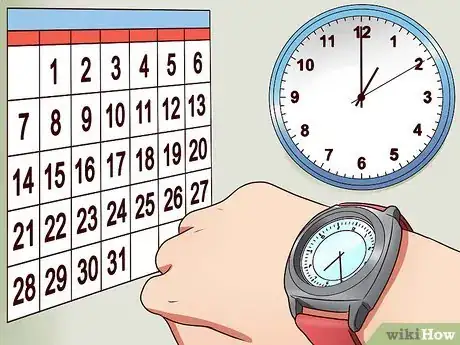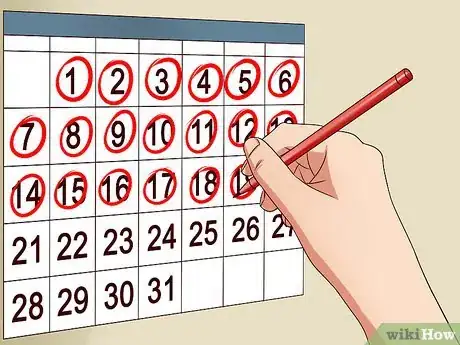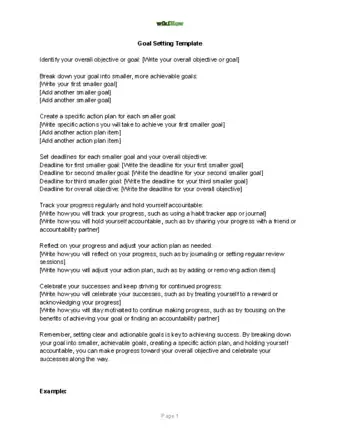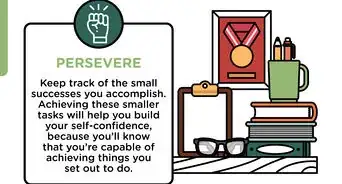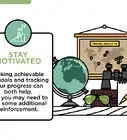This article was co-authored by Sydney Axelrod. Sydney Axelrod is a certified life coach and the owner of Sydney Axelrod LLC, a life coaching business focused on professional and personal development. Through one-on-one coaching, digital courses, and group workshops, Sydney works with clients to discover their purpose, navigate life transitions, and set and accomplish goals. Sydney has over 1,000 hours of relevant coaching certifications and holds a BBA in Marketing and Finance from Emory University.
There are 13 references cited in this article, which can be found at the bottom of the page.
This article has been viewed 97,163 times.
Everybody has things they'd like to achieve in life. Setting goals and achieving them not only gets things done, but can also build self-esteem, happiness, and a sense of well-being.[1] This is more likely to happen if your goals are realistic. Realistic goals are also more motivating than those that set the bar too high.[2]
Steps
Making Your Goals Realistic
-
1Assess your commitment. Once you have an idea of what it will take to achieve your goal, you can determine whether you are committed enough to follow through. You must be determined to put in the necessary time and effort to achieve your goals.[3]
- Especially if your goal is a difficult or complicated one, you must be fully committed to it. You are less likely to achieve a goal that is only somewhat important to you.
- If your aren't sure you are committed enough to follow through on a goal or goals, it probably isn't realistic. This means you should either revise your goal or create a new one you are more committed to.
- Let's stick with the example of becoming a professional cellist. You might decide that moving to another city is something you can't commit to. If there isn't a professional orchestra in your town, you'll need to revise your career goal.
- If you have multiple goals on your list, it is a good idea to rank them in order of how important to you they are. Trying to achieve too many goals at once can make it harder to achieve any of them. Go for the ones you are most committed to first.
-
2Consider personal limitations. You've probably heard people say that if you put your mind to it, you can accomplish anything. In some cases, this is true. In other cases, your personal limitations might make a goal unrealistic. So, you should consider whether the goals you've set are reasonable for you.[4]
- Limitations come in many forms. They can be monetary, for example. They can also be physical. While some can be overcome, others might present too much of challenge. In such cases, you may wish to revise or reconsider one of your goals.
- Let's stick with the career as a cellist as an example. If you've been in a car accident and don't have full use of your hands, this will make achieving this goal much more difficult. You might be able to overcome this through intensive physical therapy and years of training. Certainly though, it will make the goal much harder, and might make it impossible. You should keep this in mind while assessing whether your goal is realistic.
- Write your limitations down. This will help you develop a more complete picture of the challenges you face.
Advertisement -
3Determine the external obstacles. Aside from your own limitations, most goals also involve overcoming external obstacles. These are things that might happen, outside of your control, that could make it harder to achieve your goal. You should take such obstacles into account.[5]
- For example, think about the music school you want to attend for cello training. How difficult is it to get accepted to that school? How likely are you to be accepted? What if you aren't accepted? What other options are open to you?
- You won't be able to anticipate every obstacle that might arise, but try to brainstorm as many as you can, writing them down as you go. This will help you develop a sense of how realistic your goal is.
- This can also be helpful later if you do decide to pursue your goal. Trying to anticipate obstacles in advance helps you develop ideas for dealing with them when they arise.
-
4Revise if necessary. After careful consideration, you may decide your goal is realistic. If so, you can move on to working toward making it a reality. If not, you're going to need to revise your goals.
- If you decide your goal isn't realistic, you have two options. You can try to revise the goal to make it more achievable. Or, you can let it go in favor of creating a new goal.
- For example, imagine you've decided that a career as a professional cellist isn't realistic for you. If your big-picture goal is a more fulfilling career, it's time to go back to the drawing board. Think about some other careers that would also make you happy.
- Keep in mind that this doesn't mean you need to give up on the cello. If you love music and the cello, you can also revise your goal. You can aim to learn the cello and play it as a hobby. This goal would be less challenging and might be more realistic for you and your current circumstances.
Brainstorming Goals
-
1Think about what you want to achieve. The first step in setting any goal is deciding what you want. Most people have a general sense of things they want. It might be happiness, health, wealth, or a better relationship with your spouse. Your first tasks is translating that into some things you'd like to actually accomplish.[6]
- A good place to start is defining your terms. If you want to be happier, think about what happiness means to you. What does a happy life look like? What would you need to do to be happy?[7]
- It's okay to be general at this stage. You might decide happiness, for example, means having a fulfilling career. Your general goal might be to get a job you find personally satisfying.
- You may have several goals at this stage, some long-term some short term. It's a good idea to write them down.
-
2Get specific. Before you can determine if a goal is realistic, you have to make that goal specific. This will provide greater clarity in terms of what you actually would have to do to achieve it. Specific goals are also more motivating and achievable than vague ones.[8]
- Your task at this stage is to take your general ideas and get as specific as you possibly can.[9]
- For example, imagine you goal is to start a new, more satisfying career. At this stage, you need to decide what career would be most satisfying to you. You might decide you'd like to become a professional musician. That's a great start, but you can get more specific. What style or styles of music do you want to play? What instrument or instruments do you want to play? Do you want to be a solo artist, or play in a band or orchestra?
-
3Do some research. Determining how challenging a goal is might require some research, if you aren't already familiar with the process. The more you know about the process the better.[10] As you do your research, try to answer questions like:
- What skills will you need to learn?
- What lifestyle changes will you need to make?
- How much will it cost?
- How long will it take?
-
4Determine the steps. To determine if a goal is realistic, you must know exactly how a goal would be achieved. In this step, you need to break your goal or goals into parts or steps.[11]
- Breaking your goal down into subgoals will also help you make a plan for achieving it later on.[12] It's a good idea to write the steps down as you go.
- For example, imagine your goal is to become a professional cello player with a classical orchestra. In general terms, this goal breaks down into several steps. You'll need to buy a cello, if you don't have one. You'll need to get very good at playing it. This will probably require taking lessons. You probably will even want to attend a conservatory or other music school or college. Along the way, you'll probably need to learn some musical theory. Then, you'll need to get a job playing for an orchestra. This will mean at least one (and probably several) auditions. Depending on where you live, this might require moving to a town with a professional orchestra.
Achieving Your Goals
-
1Make a plan. Once you've settled on an realistic goal, your first step is to create a detailed plan for achieving it.[13]
- This should be fairly easy at this point. You have already written down the steps and potential obstacles you might face. The main parts of your plan are already developed.
- You may need to get a little more specific with your steps. For example, if you are applying to a music school, you'll want to include the details of the application process in your plan. You might need to get letters of recommendation. There might be an essay to write, a form to fill out, and/or an audition. Completing all of these should be in your plan.[14]
- The steps should be defined specifically enough that it will be clear when you have achieved each one.
- It's also a good idea to develop contingency plans for the obstacles you anticipated. If you aren't accepted to your first choice school, will you apply to other schools? Or wait and apply to your first choice again after strengthening your application?
- Come up with a goal/sub-goal statement which is measurable and time bound. For example: "I will save 20% of my weekly pay for the next 12 months and will purchase my cello on June 1st 2016."
-
2Set a timeline. Many people find having a specific timeline in their plan helps make their goal more achievable. It helps you track your progress an stay accountable.[15]
- For example, you might aim to have money saved for a cello in six months. You might start lessons the following month. You might aim to have mastered the basics by the end of the year, and so on.
-
3Get to work. Once you've got a detailed plan, pick a date to begin and dive in! The only way to achieve your goal is to put in the necessary time and effort.[16]
- Picking a date that's at least a few days in the future can help you build anticipation and motivation as the date approaches.
-
4Track your progress. Once you get started, keep track of your progress. You can use a journal, an app, or a simple calendar.[17]
- Tracking your progress helps keep you accountable to the deadlines you've set.
- It also helps you see the progress you've made as you move through the process. This can help you stay motivated to keep making progress.
Goal Setting Template
Expert Q&A
Did you know you can get expert answers for this article?
Unlock expert answers by supporting wikiHow
-
QuestionHow do you set clear goals?
 Sydney AxelrodSydney Axelrod is a certified life coach and the owner of Sydney Axelrod LLC, a life coaching business focused on professional and personal development. Through one-on-one coaching, digital courses, and group workshops, Sydney works with clients to discover their purpose, navigate life transitions, and set and accomplish goals. Sydney has over 1,000 hours of relevant coaching certifications and holds a BBA in Marketing and Finance from Emory University.
Sydney AxelrodSydney Axelrod is a certified life coach and the owner of Sydney Axelrod LLC, a life coaching business focused on professional and personal development. Through one-on-one coaching, digital courses, and group workshops, Sydney works with clients to discover their purpose, navigate life transitions, and set and accomplish goals. Sydney has over 1,000 hours of relevant coaching certifications and holds a BBA in Marketing and Finance from Emory University.
Certified Life Coach
References
- ↑ McGregor, I., & Little, B. R. (1998). Personal projects, happiness, and meaning: on doing well and being yourself. Journal of personality and social psychology, 74(2), 494.
- ↑ Brunstein, J. C. (1993). Personal goals and subjective well-being: A longitudinal study. Journal of Personality and Social Psychology, 65, 1061–1070.
- ↑ Koestner, R., Lekes, N., Powers, T. A., & Chicoine, E. (2002). Attaining personal goals: Self-concordance plus implementation intentions equals success. Journal of Personality and Social Psychology, 83, 231–244.
- ↑ Brunstein, J. C. (1993). Personal goals and subjective well-being: A longitudinal study. Journal of Personality and Social Psychology, 65, 1061–1070.
- ↑ https://fisher.osu.edu/blogs/leadreadtoday/blog/dont-let-obstacles-set-you-back-with-your-goal-plan-for-them
- ↑ Sydney Axelrod. Certified Life Coach. Expert Interview. 30 June 2020.
- ↑ Fischhoff, B., Slovic, P., & Lichtenstein, S. (1988). Knowing what you want: Measuring labile values. Decision Making: Descriptive, Normative and Prescriptive Interactions, Cambridge University Press, Cambridge, 398-421. (Chapter 18)
- ↑ Austin, J. T., & Vancouver, J. B. (1996). Goal constructs in psychology: Structure, process, and content. Psychological Bulletin, 120, 338 –375.
- ↑ Sydney Axelrod. Certified Life Coach. Expert Interview. 30 June 2020.
- ↑ https://www.indeed.com/career-advice/career-development/goal-setting-tips
- ↑ https://www.indeed.com/career-advice/career-development/goal-setting-tips
- ↑ Sydney Axelrod. Certified Life Coach. Expert Interview. 30 June 2020.
- ↑ https://inside.ewu.edu/calelearning/psychological-skills/goal-setting/
- ↑ Sydney Axelrod. Certified Life Coach. Expert Interview. 30 June 2020.
- ↑ https://www.indeed.com/career-advice/career-development/how-to-write-an-action-plan
- ↑ https://www.wearewithyou.org.uk/help-and-advice/advice-you/how-set-smart-goals/
- ↑ https://business.gov.au/planning/business-plans/set-goals-for-your-business
- ↑ Sydney Axelrod. Certified Life Coach. Expert Interview. 30 June 2020.
About This Article
To set realistic goals, start by coming up with some specific goals, like losing 10 pounds in 3 months or enrolling in a graduate program by the end of the year. Then, look at your goals and ask yourself how committed you are to achieving them and if there are any obstacles that will get in your way. If you have doubts or think your goals seem impossible, try adjusting them so they're a little more realistic. For example, maybe you'll try to lose 10 pounds in 5 months instead of 3, or enroll in graduate school by the end of next year instead of this year. To learn how to achieve your goals once you set them, scroll down!










